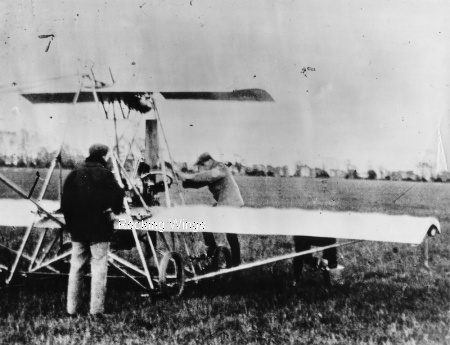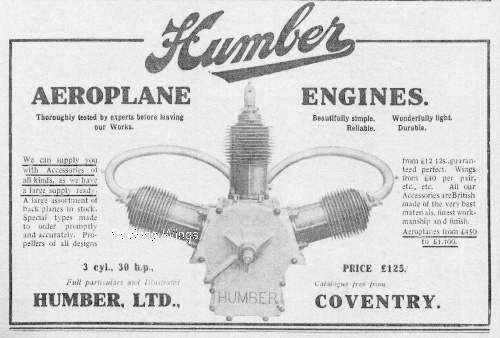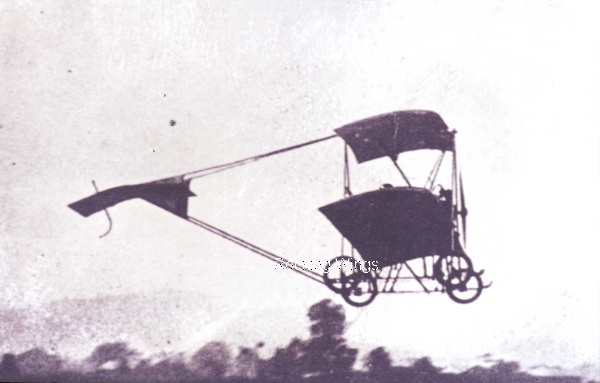In his second aeroplane, Preston Watson achieved successful powered flight in a design that seemed to vindicate his theories, although when exactly his first flight in a rocking wing aeroplane took place is not known. The earliest photographs unearthed so far of Watson's No.2 machine in flight are dated from 1912. Was this the year in which he flew a powered aeroplane for the first time?
Assumed to have been completed in 1912; it could not have been built any earlier than 1910 based on the construction date of its engine, Watson's No.2 was structurally identical to its predecessor, which lends credence to the fact that Watson's first rocking wing aircraft did not fly. The two aircraft shared the same dimensions, wing plan and boxkite tail surfaces, although the 'A' frame centre section of the No.2 differed slightly from the No.1 in bracing details.
Its wing was one piece, like that of the patent illustration, with a cut-out at its centre for the pilot to sit. Of the same reverse sesquiplane configuration as its predecessor, the No.2's wings were constructed with an exaggerated camber, a considerable increase over the profile of the wings of the No.1. Skids were fitted to the underside of the boxkite at the tail and on each wingtip.
In photographs of the No.2 at rest on the ground there is a mild anhedral angle to the wings, which are heavily braced by two struts under each wing. With its boxkite tail slumped rearwards and its droopy wings, the No.2 looked a little saggy; its less-than polished finish betrayed its 'home-made' origins.
Although also fitted with skids that protruded ahead of the propeller arc, the No.2 sat on wheels that were bungee-sprung. Its suspension system was unsophisticated, but effective for its time. The two axles were suspended by stretched bungee cord between a framework of horizontally mounted struts at the base of the fore and aft 'A' frames, providing a wide-track, four wheel truck to ride on.

Watson's No.2 being prepared for flight, probably at Errol in 1912. The overall size of the aircraft is evident in this image. Philip Jarrett
To power his new aeroplane Watson paid £125 for a brand new three-cylinder 30 hp Humber engine purchased direct from the manufacturers, which drove a five foot diameter propeller. Perched on the wing leading edge between the two uprights, the No.2's Humber was fed by a single cylindrical tank positioned underneath the leading edge of the rocking wing.
Described as "beautifully simple, wonderfully light, reliable, durable..." in advertising literature of the day, the 30 hp Humberwas a compact air-cooled engine built by the aviation department of the notable British automotive manufacturers based in Coventry. Having undertaken licence production of the Blériot aeroplane that Louis Blériot flew to Dover from Calais in July 1909, Humber its own powerplant to fit to the ubiquitous type, which was similar in layout to the Blériot's nominal French made engine, the three-cylinder 20 hp Anzani.
It is possible that Humber also manufactured the No.2's propeller, as their advertising blurb quotes that the firm made, "...propellers of all designs from £12 12s., guaranteed perfect." To incorporate components manufactured to order would have made the completion of Watson's machine much easier than it had previously; after all, propeller design and manufacture was a precise and exacting task.
Humber offered "...high-class workmanship, finest materials, reliable and British manufactured spares..."; since Preston bought one of their engines, why would he not buy a propeller expertly made to order from the same firm?

An advertisement for the three cylinder 30 hp Humber engine fitted to Watson's No.2. Its general configuration can be made out in the previous image. The Aero via the National Museums of Scotland
At the time it flew in 1912, the No.2 was sporting a new tailplane of simpler design, comprising a single elevator with small triangular fillets in between the fuselage attachment struts acting as a side area component at the rear of the aircraft. Although of poor quality, the pictures taken of the No.2 in flight at Errol show the wing rocking feature in action, there being little lateral movement by the aircraft.
Based on the testimony of James Manson, a labourer with Watson's father's food produce firm, he was invited by Preston to repair the new aeroplane at Errol during its flight testing because of his mechanical knowledge. Mr Manson remembered the year as 1908, but for the reasons stated above, this is not correct.
A number of accounts, no doubt originating from James Watson, state that Preston, James and Archie Dicke, who allegedly went to Paris to secure a Dutheil Chalmers engine from Alberto Santos-Dumont for Watson's previous aeroplane, all flew the machine at Errol at this time. The pictures have been mis-quoted by James as having been taken in 1908, but the No.2's 30 hp Humber engine was not produced until 1910. On being given this piece of rather pointed evidence to the contrary by Charles Gibbs-Smith, James Watson promptly changed his story.
Little of real data survives on the No.2, presumably of lesser significance in Watson's mind than his next aircraft. It is highly likely that because of his failure to fly his No.1, Watson considered his No.2 to be purely a concept demonstrator (to quote a modern phrase) before moving on to build a machine that was capable of proving its practicability.
Again, as with his first aeroplane, it is safe to assume that Watson's primary concern about the No.2 would have been its powerplant; above all other considerations, he had to equip it with an engine that was able to get it into the air. Quite probably, his choice of engine was driven by cost and availability; perhaps he was impressed with the advertisements Humber had placed in magazines such as The Aero? Or was it because the three-cylinder Humber engine was based on Blériot's Anzani in his No.XI aeroplane that he crossed the English Channel with? This might also explain why Watson chose a British built Anzani power his next aeroplane.
As with his first aeroplane, the fate of the Watson No.2 is unknown, although it was probably scrapped with the outbreak of the Great War, like Watson's last aeroplane.
Now, read about Watson's third aeroplane here
